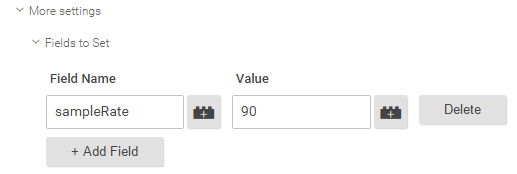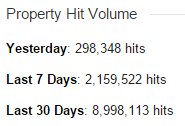Google Analytics 10M Hit Limit: What Are My Options?

If you’re reading this blog post, chances are you’ve received a message from Google Analytics that felt a bit like a detonating bomb:

Your data volume (xM hits) exceeds the limit of 10M hits per month as outlined in our Terms of Service. If you continue to exceed the limit, you may lose access to future data.
Take a deep breath. You have some options, and we’ll talk about them here.
As the Manager of Analytics here, I want to share with you our approach to this problem and how we’re handling it for our own clients.
What does the message mean?

Is our data kaput?
The free version of Google Analytics allows for up to 10 million “hits” per month, per property. (It’s in the Terms of Service you read very closely when you signed up for GA.)
What is a hit? A hit is generally a pageview or an event. A single session can have many, many hits, depending on how many pages your users look at and how many custom events you choose to fire on those pages. Every hit counts, so make sure you’re not accidentally looking at Sessions.
And what is a property? Your GA data is sent to a particular “UA” number or property, via the tracking code that you placed on the website itself. Whether you’re using JavaScript on your site or Google Tag Manager, you’re sending data to a property, where the data is collected and processed.
So you can have up to 10M hits, per month, per property, before Google drops the bomb.
It appears that the worst offenders are being notified at this time, but you should be aware that any Google Analytics property exceeding 10M hits is technically in breach of the TOS, so you should check where you stand now.
How do we know how many hits we have?
In Google Analytics, look under the Admin, under Property, and click Property Settings. Scroll down and find the Property Hit Volume. You will be able to see your hits from yesterday, the last 7 days, and the last 30 days.
You’ll also see a message here if you have exceeded your limits:

Warning! You are exceeding our limit of the allowed volume of 10M hits/month to this property, as outlined in our Terms of Service. If you continue to exceed our hit limit, you may lose access to this data.
What’s the penalty?
At this time, we really don’t know. This Google page says that “there is no assurance that the excess hits will be processed.” That’s not good, but it might imply that your data would still be accessible. But then there’s this nugget: “If the property’s hit volume exceeds this limit… you may be prevented from accessing reports.”
Whatever the penalty, it’s obvious that the days of ignoring GA’s data collection limits innocently (or otherwise) are behind us.
What are the options?
Your team’s plan of attack depends on how you choose to answer these three questions:
- What is my available marketing budget?
- How greatly am I exceeding the 10M/month/property hit limit?
- How important is comprehensive data collection to me (i.e., would a “sample” of sessions suffice)?
There are two major options you’ll have to choose from: Upgrading to Google Analytics 360 or altering your data collection. I’ve outlined the different approaches below.
Google Analytics 360
If you have budget available, the safest and most immediate way to maintain access to your data, while not sacrificing data collection, is to purchase Google Analytics 360. This could seem like an extreme option from a budget standpoint, but there are several reasons why you should consider GA360 beyond just the data question.
Let me start back at the beginning. Google Analytics 360 is the pay-per-year enterprise version of Google Analytics, that comes with three huge benefits over the free version of Google Analytics.
How much more data do I get?
Google Analytics 360 comes with much greater data limits, allowing for up to 1 billion (with a “B”) hits per month per property. (There are also higher pricing tiers for websites that exceed 1B hits.) To address that much data, GA360 comes with a variety of features to help keep the interface running quickly and without sampling (like Scheduled Unsampled Reports and Custom Tables) as well as helping you access your data in ways not available in the free version (BigQuery integration).
What kinds of features are included?
In addition, there are a variety of features and integrations that are available only to GA360subscribers, including:
- Data-driven attribution modeling – GA360 will determine which marketing channels are most effective at driving conversions, based algorithmically on the performance of your particular mix of marketing channels. The free version uses basic models and only looks at conversion traffic, but GA360 uses 100% of your traffic and advanced algorithms!
- DoubleClick integrations – Are you using DoubleClick Campaign Manager (DCM), DoubleClick Bid Manager (DBM), DoubleClick For Publishers (DFP) or DoubleClick Search (DS)? GA360 will integrate with these tools, allowing you to see impression data, cost data, and a series of rich reports for each platform.
- Roll-up reporting – If you have data in different properties, you can consolidate that data into one property with just a few clicks in the interface, and with no additional implementation required.
- 200 custom dimensions and metrics – You probably know you can customize your GA implementation by passing along additional metadata for users, sessions, pageviews, events, and even products. With GA360 you get 10x the capacity for new custom dimensions and metrics.
- SLA Support – GA360 comes with 24/7 SLA support for both GA and GTM. That means greater than 99% up-time guarantees, or your money back.
- and more…
We’ve written about this extensively – check out our great post comparing the 360 features with the free version.
How do I put it all together?

Here comes the kicker. You might think, “Why should I pay for a tool that I’ve previously been using for free for the past 5 years?” Aside for data issues, which is what prompted this whole discussion, you also get to work with a world-class Google Analytics Certified Service Partner!
Working with a Sales Partner that’s also a Service Partner means that we’re able to discuss and provide options around implementation and configuration support, training, reporting and analysis – wherever you have the greatest need. We can also deliver a private, onsite training at your company location, tailored to meet your team’s needs.
Need more info? Learn more about our Google Analytics 360 services or reach out to us if you just want to talk about options. If you’re not quite ready for GA360 yet, read on for more ways to address the issue.
Non-Google Analytics 360 Options
GA360 may not be for everyone. That’s why we wanted to offer a 5-step “Data Limit Compliance Checklist” that you should use to bring your GA implementation under the 10M hit/month/property limit. There are still ways you can keep GA and get value out of it with a smart implementation, and this might be the best opportunity you’ll ever get to reflect on what you really should be tracking on your site.
1. Audit your existing GA implementation
Sit down with your marketing team and decide how you use your Google Analytics data. What websites do you currently track in GA, and into which properties? Do you get value out of the data you have? Is your data complete, accurate and trustworthy? Do you know what you’re tracking?
It all starts and ends with strategy. Your Analytics may have been implemented years ago, by an entirely different employee or agency. Make sure you understand what’s being collected and why.
Look for common mistakes, like duplicated tracking or a poor Google Tag Manager implementation.
As you begin to investigate, you may find spam data in your reports: this is an unfortunate problem with Google Analytics at a fundamental data collection level because in actuality anyone can send data into anyone else’s Google Analytics property. Usually, this isn’t a major problem, but you should see if spam data is making up a sizable chunk of your 10M+ hits.
If it becomes apparent that some of the data you have is strategically unimportant, this is the time to clean up shop.
2. Identify what webpages or sections could be collected in different properties
If multiple websites are tracking into one property, should they be? Would you be better served to separate out entire websites from each other, or to disconnect your development or staging sites, for example?
Google Tag Manager makes it easy to track different UA numbers on different subdomains, or on different microsites, using different triggers or lookup tables.
Just be aware that if you were previously tracking multiple websites in one property, removing any of those sites will have serious repercussions on any historical data analysis. Furthermore, if you begin to track a single website across multiple properties, it will become more difficult to understand the overall picture of user behavior on your website or to accurately gauge marketing attribution.
3. Identify what hits should be dropped
We often use “events” in Google Analytics to track user activity on a page, but sometimes our custom implementation can get a little out of hand. Are there any events that you see that are useless from a reporting perspective? Are you tracking events too frequently, like firing a video event for each second played? Or maybe you are using engagement events, like scroll tracking events, that you don’t actually analyze?
The point of Google Analytics is NOT to track every single user interaction on every single page. Instead, you should only track events if they will serve some reporting purpose, or if you can imagine their analysis being helpful from a marketing or UX-design perspective. Let that be your litmus test.
Additionally, you may be tracking “user timings” or “virtual pageviews”, which also count toward your 10M hit limit. You will want to remove any excessive timings/events/pageviews in order to work toward reducing your overall hit volume.
4. Block unwanted traffic from data collection
You should consider blocking traffic from your internal IP address(es), or from your development/staging environment, to limit hits entering the property. Perhaps you’re currently using filters inside the GA Admin to filter out that traffic. Unfortunately, due to the nature of the 10M hit limit being imposed on the “property” level, filters inside Google Analytics cannot circumvent the limit, since the data will already have been collected.
From the Google documentation on data limits:
Note: Adding view filters does not reduce the number of hits you send to Google. Filters act on data that has already been collected and cannot be used to reduce your traffic levels.
Instead, the way to block the data from entering the property is to prevent it from being collected in the first place. To do that, we recommend using Google Tag Manager to exclude certain types of traffic from data collection.
5. Impose your own data sampling
Maybe that wasn’t enough. Maybe you’re still exceeding the data limits. There’s one last hope, but it’s the nuclear option.
Google Analytics allows you to configure the “sampleRate” for your implementation. This is a setting we would generally never want to adjust, because sampling makes data analysis imprecise. In this case, however, we’re out of options. We need to manually limit the number of hits that Google Analytics will collect.
For example, if you currently have 1 million users a month with around 10 million hits, you can set a 90% sample to capture approximately 900,000 users with around 9 million hits, give or take. Using Google Tag Manager, simply adjust the sample rate under “Fields to Set” in your pageview tag. You can set the sample rate to any number between 0 and 100 to include that percentage of users in your data, like so:

It’s a very inexact science, due to the changing nature of your web traffic, but with some fiddling you can reduce the total hits that are being recorded in Google Analytics.
Success?

Ideally, we’d love it if everyone upgraded to Google Analytics 360. For us, it’s a goldmine of analysis, a preponderance of data, and a land of opportunity. We love the new features and increased data limits.
Realistically, not everyone has the resources for GA360, so we hope the five steps above will help guide your response to the data volume warning.
If you’re still looking for help, call us! We are dealing with this with our clients right now, just like many of you are, and we want you to know that you don’t have to go it alone. We’ve been doing this for over 10 years, and we’d be happy to help you audit your website’s GA implementation and create a Measurement Strategy for future data collection. We’d also be happy to help you compare your options with Google Analytics 360 and make the best decision for your company. Let us know how we can help.


